and poly????For the ropes, to gets points of authenticity, they have to be made from natural fibres such as manila hemp, hemp, coir, jute, and sisal.
-

Win a Free Custom Engraved Brass Coin!!!
As a way to introduce our brass coins to the community, we will raffle off a free coin during the month of August. Follow link ABOVE for instructions for entering.
You are using an out of date browser. It may not display this or other websites correctly.
You should upgrade or use an alternative browser.
You should upgrade or use an alternative browser.
Vasa - 1:65 DeAgostini [COMPLETED BUILD]
- Thread starter dockattner
- Start date
- Watchers 147
...yep, G'uterman brand.and poly????
- Joined
- Feb 22, 2021
- Messages
- 130
- Points
- 253

Hi Paul,
I was away from forum for a while so I've just now noticed your ropes posts and dilemmas.
Your ropes looks really good. nice and tight twist.
Color is always personal taste of each individual modeler and how it will look at the model.
True... we all try to match "real look" of the ropes, but using cotton, hemp, silk, poly threads it will always create challenge at the beginning.
...but sooner or later modeler, will find the method, which suit his taste
I was experimenting with many threads.
Each has advantages and disadvantages.
I went for poly... mainly because cotton and other natural material threads are bit problematic if you want to achieve nice and smooth finish... and not like hairy caterpillar I was using for "tarring" mixture of beeswax, paraffin, turpentine and wood tar, like pine or birch.
I was using for "tarring" mixture of beeswax, paraffin, turpentine and wood tar, like pine or birch.
Cotton has also seasonal disadvantage in my climate where at home during winter we have dry air due to heating and ropes are nicely stretched and during spring and summer where humidity is higher cotton ropes are getting bit saggy
Poly threads has also plenty problems... but at least they are not loosing tension due to seasons.
Rope made of regular poly threads also looks like hairy caterpillar so I was using hot air gun (like for soldering) to deal with that to smooth it out. However, after tarring it was necessary to repeat hot air gun process to get rid of unwanted "hairs" from rope.
Poly threads has also problem with "electrostatic field" which obviously will for a dust like a magnet... so to break it a bit, we can used highly diluted shellac in pure alcohol. Shellac is natural isolator... however shellac will make ropes bit stiffer.
Then I switched myself completely to poliester silk threads (silk is just a name, and doesn't have nothing common with real silk).
I didn't have Mara threads in my hand, but looking at the photos they looks to me as just a regular poly threads.
Poly silk thread from Gutermann, which I know and I have is called Skala (in my case I have Skala 240...)
Other brands for example Serafil or Synton from Amman... not sure, what you can get in US... but if you will get thread for leather-working you will know how they look. Poly silk has a bit more shine than regular poly threads but after tarring in bitumen is not so obvious.... and that's bring us to tarring, which is a bit challenge for poly threads. Coloring them to achieve proper and durable effect, which won't rub it off it might be a problem.
Of course you can use some dye or stains... (wood based won't work so it has to be alcohol based) but I found my durable, friendly and easy method with bitumen.
You got yours from Pentart, which is ok... not as good as Idea Decoupage Liquid Bitumen No 741 by Maimeri , which I'm using... but I guess in US is not available. As you mentioned for standing rigging I'm not diluting bitumen, just taking some on top of the brush and dabbing rope in the jar from each side to cover it fully. Then I'm wiping off excess, leaving the rope for few minutes to dry... and finally when dry... I'm taking cloth damp with white spirit making few passes to remove excess of bitumen but still keep fair amount in the groves (white spirit - regular and cheap from hardware store not the one for artistic use, isopropyl alcohol works fine as well)
For running rigging I'm diluting bitumen with fair amount of white spirit. Then soaking twice whole rope in the jar, wiping off excess, drying and once again few passes thru soaked cloth.
I'm using only white or off-white threads, sometimes beige.
For ropes up to 1mm I'm using thread no 360, 250, 240...
For thicker ropes I'm going to 120, 80, 60 40...
If you will need some help let me know, we will try to do it right
Cheers,
Matt
I was away from forum for a while so I've just now noticed your ropes posts and dilemmas.
Your ropes looks really good. nice and tight twist.
Color is always personal taste of each individual modeler and how it will look at the model.
True... we all try to match "real look" of the ropes, but using cotton, hemp, silk, poly threads it will always create challenge at the beginning.
...but sooner or later modeler, will find the method, which suit his taste
I was experimenting with many threads.
Each has advantages and disadvantages.
I went for poly... mainly because cotton and other natural material threads are bit problematic if you want to achieve nice and smooth finish... and not like hairy caterpillar
 I was using for "tarring" mixture of beeswax, paraffin, turpentine and wood tar, like pine or birch.
I was using for "tarring" mixture of beeswax, paraffin, turpentine and wood tar, like pine or birch.Cotton has also seasonal disadvantage in my climate where at home during winter we have dry air due to heating and ropes are nicely stretched and during spring and summer where humidity is higher cotton ropes are getting bit saggy
Poly threads has also plenty problems... but at least they are not loosing tension due to seasons.
Rope made of regular poly threads also looks like hairy caterpillar so I was using hot air gun (like for soldering) to deal with that to smooth it out. However, after tarring it was necessary to repeat hot air gun process to get rid of unwanted "hairs" from rope.
Poly threads has also problem with "electrostatic field" which obviously will for a dust like a magnet... so to break it a bit, we can used highly diluted shellac in pure alcohol. Shellac is natural isolator... however shellac will make ropes bit stiffer.
Then I switched myself completely to poliester silk threads (silk is just a name, and doesn't have nothing common with real silk).
I didn't have Mara threads in my hand, but looking at the photos they looks to me as just a regular poly threads.
Poly silk thread from Gutermann, which I know and I have is called Skala (in my case I have Skala 240...)
Other brands for example Serafil or Synton from Amman... not sure, what you can get in US... but if you will get thread for leather-working you will know how they look. Poly silk has a bit more shine than regular poly threads but after tarring in bitumen is not so obvious.... and that's bring us to tarring, which is a bit challenge for poly threads. Coloring them to achieve proper and durable effect, which won't rub it off it might be a problem.
Of course you can use some dye or stains... (wood based won't work so it has to be alcohol based) but I found my durable, friendly and easy method with bitumen.
You got yours from Pentart, which is ok... not as good as Idea Decoupage Liquid Bitumen No 741 by Maimeri , which I'm using... but I guess in US is not available. As you mentioned for standing rigging I'm not diluting bitumen, just taking some on top of the brush and dabbing rope in the jar from each side to cover it fully. Then I'm wiping off excess, leaving the rope for few minutes to dry... and finally when dry... I'm taking cloth damp with white spirit making few passes to remove excess of bitumen but still keep fair amount in the groves (white spirit - regular and cheap from hardware store not the one for artistic use, isopropyl alcohol works fine as well)
For running rigging I'm diluting bitumen with fair amount of white spirit. Then soaking twice whole rope in the jar, wiping off excess, drying and once again few passes thru soaked cloth.
I'm using only white or off-white threads, sometimes beige.
For ropes up to 1mm I'm using thread no 360, 250, 240...
For thicker ropes I'm going to 120, 80, 60 40...
If you will need some help let me know, we will try to do it right
Cheers,
Matt
Last edited:
My goodness! That seems like a lot of work for so little gain.
Indeed it is Vic. But look at Matt's result:My goodness! That seems like a lot of work for so little gain.
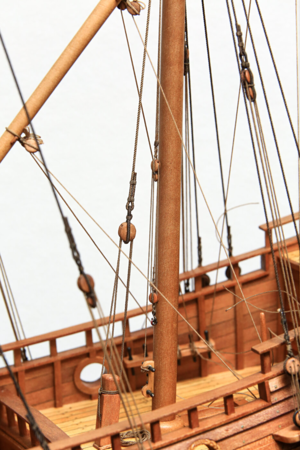
The question is - should this be attempted (approximated) at 1:65 on a ship the size of the Vasa?
So far I have not been able to replicate these lines - and it's not for lack of effort. Part of the problem is I am unable to source some of the materials I would like to experiment with here in the US (of course, the other part of the problem - and this is frankly the elephant in the room - is that I do not have the talent or experience). The US is eager to protect me from using things that might be bad for my health despite the fact that I am a grown-up (as determined by age not necessarily by maturity). If the unregulated CA didn't kill me (and it very nearly did) I would at least like to see if the Bitumen of Judea will...
Matt is correct, the Mara thread I have been using is not ideal but very available (and to be fair - makes a very nice rope). The ultrathin monofilament poly he is using is also not available in a range of colors so everything will need to be hand made (thus your 'my goodness" comment is spot-on).
And so it goes.
In the mean time absolutely nothing is getting done on my ship
Last edited:
Hey Matt ( @mati.n ),Hi Paul,
I was away from forum for a while so I've just now noticed your ropes posts and dilemmas.
Your ropes looks really good. nice and tight twist.
Color is always personal taste of each individual modeler and how it will look at the model.
True... we all try to match "real look" of the ropes, but using cotton, hemp, silk, poly threads it will always create challenge at the beginning.
...but sooner or later modeler, will find the method, which suit his taste
I was experimenting with many threads.
Each has advantages and disadvantages.
I went for poly... mainly because cotton and other natural material threads are bit problematic if you want to achieve nice and smooth finish... and not like hairy caterpillarI was using for "tarring" mixture of beeswax, paraffin, turpentine and wood tar, like pine or birch.
Cotton has also seasonal disadvantage in my climate where at home during winter we have dry air due to heating and ropes are nicely stretched and during spring and summer where humidity is higher cotton ropes are getting bit saggy
Poly threads has also plenty problems... but at least they are not loosing tension due to seasons.
Rope made of regular poly threads also looks like hairy caterpillar so I was using hot air gun (like for soldering) to deal with that to smooth it out. However, after tarring it was necessary to repeat hot air gun process to get rid of unwanted "hairs" from rope.
Poly threads has also problem with "electrostatic field" which obviously will for a dust like a magnet... so to break it a bit, we can used highly diluted shellac in pure alcohol. Shellac is natural isolator... however shellac will make ropes bit stiffer.
Then I switched myself completely to poliester silk threads (silk is just a name, and doesn't have nothing common with real silk).
I didn't have Mara threads in my hand, but looking at the photos they looks to me as just a regular poly threads.
Poly silk thread from Gutermann, which I know and I have is called Skala (in my case I have Skala 240...)
Other brands for example Serafil or Synton from Amman... not sure, what you can get in US... but if you will get thread for leather-working you will know how they look. Poly silk has a bit more shine than regular poly threads but after tarring in bitumen is not so obvious.... and that's bring us to tarring, which is a bit challenge for poly threads. Coloring them to achieve proper and durable effect, which won't rub it off it might be a problem.
Of course you can use some dye or stains... (wood based won't work so it has to be alcohol based) but I found my durable, friendly and easy method with bitumen.
You got yours from Pentart, which is ok... not as good as Idea Decoupage Liquid Bitumen No 741 by Maimeri , which I'm using... but I guess in US is not available. As you mentioned for standing rigging I'm not diluting bitumen, just taking some on top of the brush and dabbing rope in the jar from each side to cover it fully. Then I'm wiping off excess, leaving the rope for few minutes to dry... and finally when dry... I'm taking cloth damp with white spirit making few passes to remove excess of bitumen but still keep fair amount in the groves (white spirit - regular and cheap from hardware store not the one for artistic use, isopropyl alcohol works fine as well)
For running rigging I'm diluting bitumen with fair amount of white spirit. Then soaking twice whole rope in the jar, wiping off excess, drying and once again few passes thru soaked cloth.
I'm using only white or off-white threads, sometimes beige.
For ropes up to 1mm I'm usisng thread no 360, 250, 240, 120...
For thicker ropes I'm oing to 80, 60 40...
If you will need some help let me know, we will try to do it right
Cheers,
Matt
Thank you for your helpful post. From it I learned that you are starting with thinner source thread than I was using (my smallest was 120). I believe the thinner poly silk you are using is closer to a monofilament which would solve my S twist rope problem as well.
I am also surprised to learn that most of your source threads are white/off white. I have been limiting myself to hemp colored threads. @kirill4 linked me to a method for tinting ropes using oil paints and that method has worked very well in my experiments but leaves a rope that is uniform in color and I think I am looking for something more varied.
I have contacted Maimeri but I believe that will go nowhere. I agree with @Jimsky - the Pentart color is a bit unappealing - but it may be all I can get.
.
Paul,
I liked and agree everything Matt said ... actually my experience says the same to me , at least I've passed same stages as Matt did ))...
))...
and stopped on GUTERMANN TERA or for best results Poly silk thread Skala ...
colors preferable need to be white or slightly colored... actually it doesn't matter which color they are(but only must not be red or green! )), later they will be painted in necess-ry color anyway...
)), later they will be painted in necess-ry color anyway...
Strange to hear that method of coloring them by mix of tick oil deluted in whitespirit and artistic oil paint didn't work ... did You use all mentioned components ?and apply mix as advised?
This should work the same way as Matt advised to use and apply bitumen liquid on the rope, the only difference in colors which You will get in the end.
Using bitumen alone You will get only variation of brownish colors, from dark to bright...as on Matti model...
But using / adding artistic oil paints , Umber and Gold Ochre to this mix, I think we could add them strait to the bitumen diluted with whitespirit, We will get more natural hemp colors for running rigging and more intensive, dark -for standing rigging.
Which exactly colors we will get purely depends on master own test, but at least it should be very close to natural hemp colors, but not too much white as we often could see on many models.- I understood very bright color for rigging if it should imitate modern synthetic rope , but it looks very strange on period ship models
I liked and agree everything Matt said ... actually my experience says the same to me , at least I've passed same stages as Matt did
and stopped on GUTERMANN TERA or for best results Poly silk thread Skala ...
colors preferable need to be white or slightly colored... actually it doesn't matter which color they are(but only must not be red or green!
Strange to hear that method of coloring them by mix of tick oil deluted in whitespirit and artistic oil paint didn't work ... did You use all mentioned components ?and apply mix as advised?
This should work the same way as Matt advised to use and apply bitumen liquid on the rope, the only difference in colors which You will get in the end.
Using bitumen alone You will get only variation of brownish colors, from dark to bright...as on Matti model...
But using / adding artistic oil paints , Umber and Gold Ochre to this mix, I think we could add them strait to the bitumen diluted with whitespirit, We will get more natural hemp colors for running rigging and more intensive, dark -for standing rigging.
Which exactly colors we will get purely depends on master own test, but at least it should be very close to natural hemp colors, but not too much white as we often could see on many models.- I understood very bright color for rigging if it should imitate modern synthetic rope , but it looks very strange on period ship models
Last edited:
Hmm. I have not tried the bitumen treatment on the lines colored with oil paint. I stopped at the burnt umber coloration (diluted in linseed oil in my case which is the carrier for the pigment in the first place) which did turn out very nice but monochromatic. I'm on holiday. When I return home I'll give that a try.liked and agree everything Matt said ... actually my experience says the same to me , at least I've passed same stages as Matt did))...
and stopped on GUTERMANN TERA or for best results Poly silk thread Skala ...
colors preferable need to be white or slightly colored... actually it doesn't matter which color they are(but only must not be red or green!)), later they will be painted in necess-ry color anyway...
Strange to hear that method of coloring them by mix of tick oil deluted in whitespirit and artistic oil paint didn't work ... did You use all mentioned components ?and apply mix as advised?
This should work the same way as Matt advised to use and apply bitumen liquid on the rope, the only difference in colors which You will get in the end.
Using bitumen alone You will get only variation of brownish colors, from dark to bright...as on Matti model...
But using / adding artistic oil paints , Umbra and Gold Ochre to this mix, I think we could add them strait to the bitumen diluted with whitespirit, We will get more natural hemp colors for running rigging and more intensive, dark -for standing rigging.
Which exactly colors we will get purely depends on master own test, but at least it should be very close to natural hemp colors, but not too much white as we often could see on many models.- I understood very bright color for rigging if it should imitate modern synthetic rope , but it looks very strange on period ship models
I see ... as I understood we were talking about umber color for standing rigging, and mix of umber and gold ochre for running...not "burnt umber" color - they are different...
and as I understood there is special way how to apply it - I see that Matt and D.Shevelev both follow more or less the same rules ...
from Matt:
....As you mentioned for standing rigging I'm not diluting bitumen, just taking some on top of the brush and dabbing rope in the jar from each side to cover it fully. Then I'm wiping off excess, leaving the rope for few minutes to dry... and finally when dry... I'm taking cloth damp with white spirit making few passes to remove excess of bitumen but still keep fair amount in the groves (white spirit - regular and cheap from hardware store not the one for artistic use, isopropyl alcohol works fine as well)
For running rigging I'm diluting bitumen with fair amount of white spirit. Then soaking twice whole rope in the jar, wiping off excess, drying and once again few passes thru soaked cloth.....
....D.Shevelev use cotton gloves for the same purpose...
when excess of bitumen (oil mix of artistick oil paints with tick oil and white spirit) will be removed in such way , but still fair amount of pigments/paint will remains in the groves , thus giving nice relief to the rope and helps to avoid monochromatic appearance....
as example , using two methods of painting rigging ...
first , same as Matt used - bitumen liquid in different consistency
models of D.Shevelev https://www.shipmodeling.ru/phpbb/viewtopic.php?f=65&t=71120 ,
here , on this model , rigging and entire model as well painted bitumen liquid as he said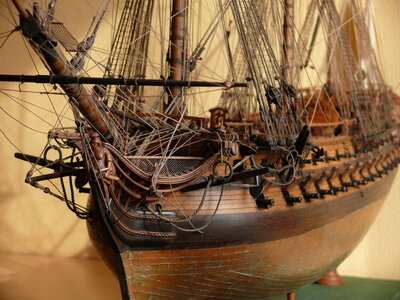
and on this model https://www.shipmodeling.ru/phpbb/viewtopic.php?f=65&t=5418&start=405
, rigging painted by artistic oil paints umber for standing and umber + gold ochre for running , both diluted in tick oil and whitespirit for better performance when drying... this I like much more and planned to use this way of rope painting in future for my models
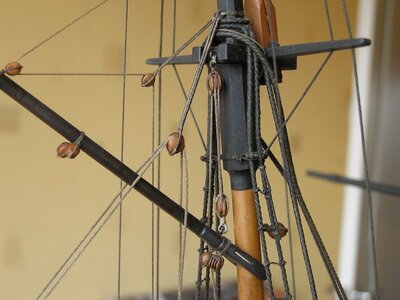
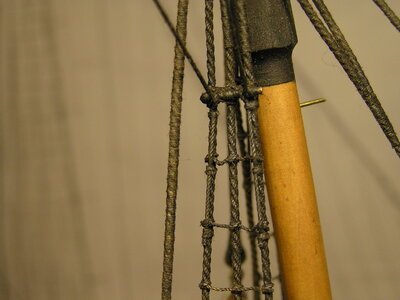
and as I understood there is special way how to apply it - I see that Matt and D.Shevelev both follow more or less the same rules ...
from Matt:
....As you mentioned for standing rigging I'm not diluting bitumen, just taking some on top of the brush and dabbing rope in the jar from each side to cover it fully. Then I'm wiping off excess, leaving the rope for few minutes to dry... and finally when dry... I'm taking cloth damp with white spirit making few passes to remove excess of bitumen but still keep fair amount in the groves (white spirit - regular and cheap from hardware store not the one for artistic use, isopropyl alcohol works fine as well)
For running rigging I'm diluting bitumen with fair amount of white spirit. Then soaking twice whole rope in the jar, wiping off excess, drying and once again few passes thru soaked cloth.....
....D.Shevelev use cotton gloves for the same purpose...
when excess of bitumen (oil mix of artistick oil paints with tick oil and white spirit) will be removed in such way , but still fair amount of pigments/paint will remains in the groves , thus giving nice relief to the rope and helps to avoid monochromatic appearance....
as example , using two methods of painting rigging ...
first , same as Matt used - bitumen liquid in different consistency
models of D.Shevelev https://www.shipmodeling.ru/phpbb/viewtopic.php?f=65&t=71120 ,
here , on this model , rigging and entire model as well painted bitumen liquid as he said

and on this model https://www.shipmodeling.ru/phpbb/viewtopic.php?f=65&t=5418&start=405
, rigging painted by artistic oil paints umber for standing and umber + gold ochre for running , both diluted in tick oil and whitespirit for better performance when drying... this I like much more and planned to use this way of rope painting in future for my models


Vic, who said it will be easy???My goodness! That seems like a lot of work for so little gain.
- Joined
- Feb 22, 2021
- Messages
- 130
- Points
- 253

Hi All,
Paul... of course you will be able to make beautiful ropes for Vasa in 1/65.
It's quite a big vessel... and much more heavily rigged then my small pinnace.
Yes... I'm using really thin threads for small diameter ropes. Most of them (thin and thick ropes) are made of multiple threads on each ropewalk hook. This gives me more control on diameter... in fact... by that I can make any diameter I want
I'm coloring ropes in bitumen so it's no point to have any other fancy colors of threads. White, off-white, beige works great. In fact gives you more control of your desire final effect. If it's to bright... then you dump it again in bitumen, dry, wipe to the point when you are happy with result.
It's a matter of practice... after some time you will know how and how many time treat your rope for desire look
@kirill4 D.Shevelev is exceptional model builder. I know his work already few years and it's just a simply an art.
However I was not aware he is using bitumen or oil paint for ropes
When I was looking for my method I was just going product by product and testing it on the ropes... so it took me some time to get final conclusions.
I'm happy to slide an idea to others so they might find it helpful or even improve similar methods.
...but you are right. Oil paints looks good too... and yes... you have more "shades" to play...
It depends what effect you are looking for.
I like bitumen method and shades on older vessels, where you look for vintage style of rigging... at least me
If I would build a bit "younger" vessel probably I will go more in grey - beige shades of running rigging... but again... this has to match overall model appearance and blend seamless.
@Jimsky Jim... you are right... it should be easy... otherwise, where is the fun?
@Steef66 and @Ondras71 maybe this thread will be interesting for you as we were having some rope conversation earlier.
Cheers,
Matt
Paul... of course you will be able to make beautiful ropes for Vasa in 1/65.
It's quite a big vessel... and much more heavily rigged then my small pinnace.
Yes... I'm using really thin threads for small diameter ropes. Most of them (thin and thick ropes) are made of multiple threads on each ropewalk hook. This gives me more control on diameter... in fact... by that I can make any diameter I want
I'm coloring ropes in bitumen so it's no point to have any other fancy colors of threads. White, off-white, beige works great. In fact gives you more control of your desire final effect. If it's to bright... then you dump it again in bitumen, dry, wipe to the point when you are happy with result.
It's a matter of practice... after some time you will know how and how many time treat your rope for desire look
@kirill4 D.Shevelev is exceptional model builder. I know his work already few years and it's just a simply an art.
However I was not aware he is using bitumen or oil paint for ropes
When I was looking for my method I was just going product by product and testing it on the ropes... so it took me some time to get final conclusions.
I'm happy to slide an idea to others so they might find it helpful or even improve similar methods.
...but you are right. Oil paints looks good too... and yes... you have more "shades" to play...
It depends what effect you are looking for.
I like bitumen method and shades on older vessels, where you look for vintage style of rigging... at least me
If I would build a bit "younger" vessel probably I will go more in grey - beige shades of running rigging... but again... this has to match overall model appearance and blend seamless.
@Jimsky Jim... you are right... it should be easy... otherwise, where is the fun?

@Steef66 and @Ondras71 maybe this thread will be interesting for you as we were having some rope conversation earlier.
Cheers,
Matt
Hello, Paul. I have obtained Maimeri bitumen patina 710 thru the Russian store.I have contacted Maimeri but I believe that will go nowhere. I agree with @Jimsky - the Pentart color is a bit unappealing - but it may be all I can get.
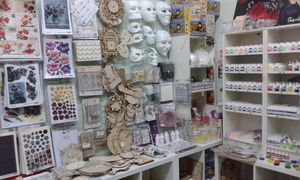
Магазин мастера Декупажная лавка (decoy-shop) на Ярмарке Мастеров | Серпухов
Магазин мастера Декупажная лавка (decoy-shop) на Ярмарке Мастеров. Присоединяйся к самой крупной торговой площадке для покупки и продажи handmade-товаров и дизайнерских вещей.
I sent her an email to find out if they still have the stock.
- Joined
- Feb 22, 2021
- Messages
- 130
- Points
- 253

Hi Jim,
710 is product for aging effects on metals, like gold bronze, silver etc... but I might be wrong, however I think it has bit different mix... possibly with some hardeners for more solid layer
I'm using 741 which is product for decoupage, however it's just pure Judea bitumen slightly thinned with white spirit.
710 is product for aging effects on metals, like gold bronze, silver etc... but I might be wrong, however I think it has bit different mix... possibly with some hardeners for more solid layer
I'm using 741 which is product for decoupage, however it's just pure Judea bitumen slightly thinned with white spirit.
Many thanks, Matti. Apparently, it is a different product. I saw this product in Russian stores, a pity they don't ship to the USA.
Oh well, I will try using 710. Many Russian modelers recommend the 710 for the hull aging process maybe it will work on ropes as well.
Oh well, I will try using 710. Many Russian modelers recommend the 710 for the hull aging process maybe it will work on ropes as well.
Good day Paul,
Found recently...I didn't read it yet, but could be interesting!
The author compares the hull construction of the Vasa with Witsen's standard work.
Part of the work is the creation of a very detailed 3D model.
Lots of pictures.
http://oaktrust.library.tamu.edu/handle/1969.1/153363
Found recently...I didn't read it yet, but could be interesting!
The author compares the hull construction of the Vasa with Witsen's standard work.
Part of the work is the creation of a very detailed 3D model.
Lots of pictures.
http://oaktrust.library.tamu.edu/handle/1969.1/153363
Awesome find, Kirill!
Fantastic Kirill! I look forward to reading more about the construction of this fascinating ship! Thank you for sharing this find with me and the forum.Good day Paul,
Found recently...I didn't read it yet, but could be interesting!
The author compares the hull construction of the Vasa with Witsen's standard work.
Part of the work is the creation of a very detailed 3D model.
Lots of pictures.
http://oaktrust.library.tamu.edu/handle/1969.1/153363
Hello Fellow Modelers,
One of the interesting aspects of this Vasa build is the ample opportunity for artistic expression in the area of painting (painting ridiculously small metal bits that is). Before the research completed at the Vasa museum about ten years ago it was universally accepted that the many wooden carvings on the ship were gilded and models were naturally presented that way. In recent years some (many?) have attempted to replicate what we now know to be true: the carvings on the Vasa were multichromatic. This introduces a new challenge to the modeler...and to THIS modeler in particular. Not only am I new to model ship building - but I am new to painting miniatures of any kind. The learning curve is a steep one in both regards.
Here, with humility, I present two postings that show what I have been working on in recent weeks (along with my rope making experiments).
First of all I'll show two parts that form the most forward decoration and the most aft decoration on the ship: the lion at the front and the lions (and crest) at the back:
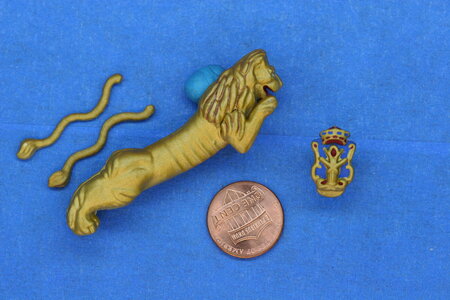
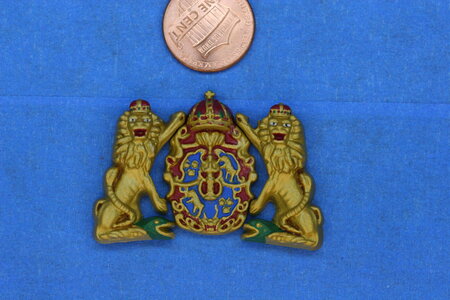
As you can see I have chosen to flatten the gold. As far as I can tell from my research these parts were not gilded - so I have chosen to present them as painted in a gold color.
Next up are a series of Roman soldiers that will appear on the underside of the lower of the paired galleries.
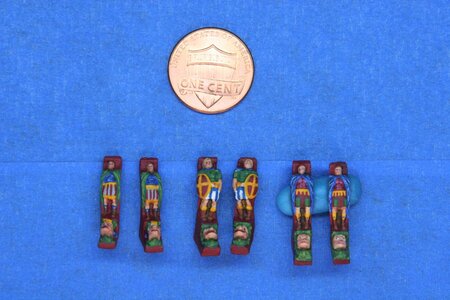
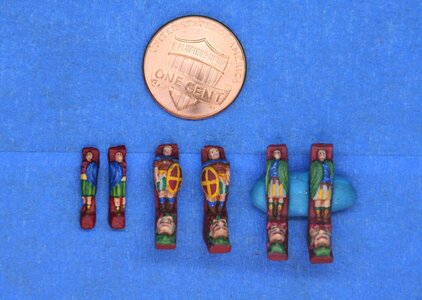
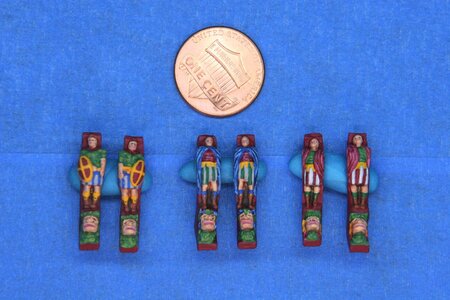
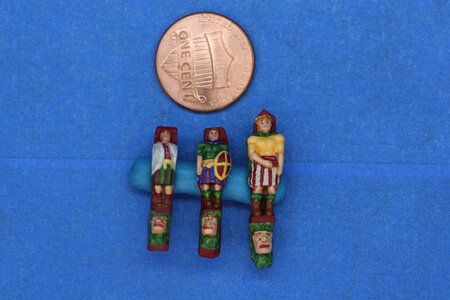
The last image only shows one of a pair - I simply took the photo wrong.
In the next posting the art exhibit will continue (I learned I can only include a limited number of photos in a single post...).
One of the interesting aspects of this Vasa build is the ample opportunity for artistic expression in the area of painting (painting ridiculously small metal bits that is). Before the research completed at the Vasa museum about ten years ago it was universally accepted that the many wooden carvings on the ship were gilded and models were naturally presented that way. In recent years some (many?) have attempted to replicate what we now know to be true: the carvings on the Vasa were multichromatic. This introduces a new challenge to the modeler...and to THIS modeler in particular. Not only am I new to model ship building - but I am new to painting miniatures of any kind. The learning curve is a steep one in both regards.
Here, with humility, I present two postings that show what I have been working on in recent weeks (along with my rope making experiments).
First of all I'll show two parts that form the most forward decoration and the most aft decoration on the ship: the lion at the front and the lions (and crest) at the back:


As you can see I have chosen to flatten the gold. As far as I can tell from my research these parts were not gilded - so I have chosen to present them as painted in a gold color.
Next up are a series of Roman soldiers that will appear on the underside of the lower of the paired galleries.




The last image only shows one of a pair - I simply took the photo wrong.
In the next posting the art exhibit will continue (I learned I can only include a limited number of photos in a single post...).
Very intricate. How many of these pieces are there to paint?Hello Fellow Modelers,
One of the interesting aspects of this Vasa build is the ample opportunity for artistic expression in the area of painting (painting ridiculously small metal bits that is). Before the research completed at the Vasa museum about ten years ago it was universally accepted that the many wooden carvings on the ship were gilded and models were naturally presented that way. In recent years some (many?) have attempted to replicate what we now know to be true: the carvings on the Vasa were multichromatic. This introduces a new challenge to the modeler...and to THIS modeler in particular. Not only am I new to model ship building - but I am new to painting miniatures of any kind. The learning curve is a steep one in both regards.
Here, with humility, I present two postings that show what I have been working on in recent weeks (along with my rope making experiments).
First of all I'll show two parts that form the most forward decoration and the most aft decoration on the ship: the lion at the front and the lions (and crest) at the back:
View attachment 245967
View attachment 245968
As you can see I have chosen to flatten the gold. As far as I can tell from my research these parts were not gilded - so I have chosen to present them as painted in a gold color.
Next up are a series of Roman soldiers that will appear on the underside of the lower of the paired galleries.
View attachment 245963
View attachment 245964
View attachment 245965
View attachment 245966
The last image only shows one of a pair - I simply took the photo wrong.
In the next posting the art exhibit will continue (I learned I can only include a limited number of photos in a single post...).




